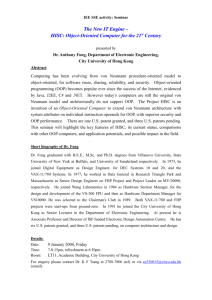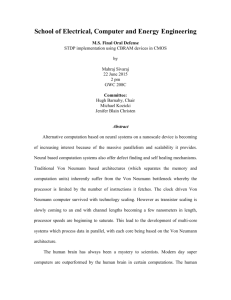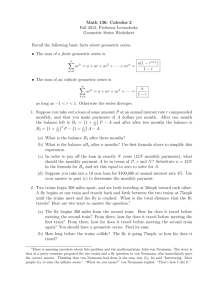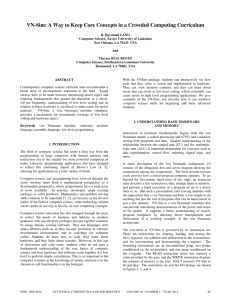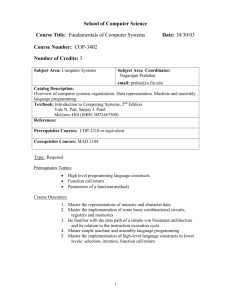Document
advertisement
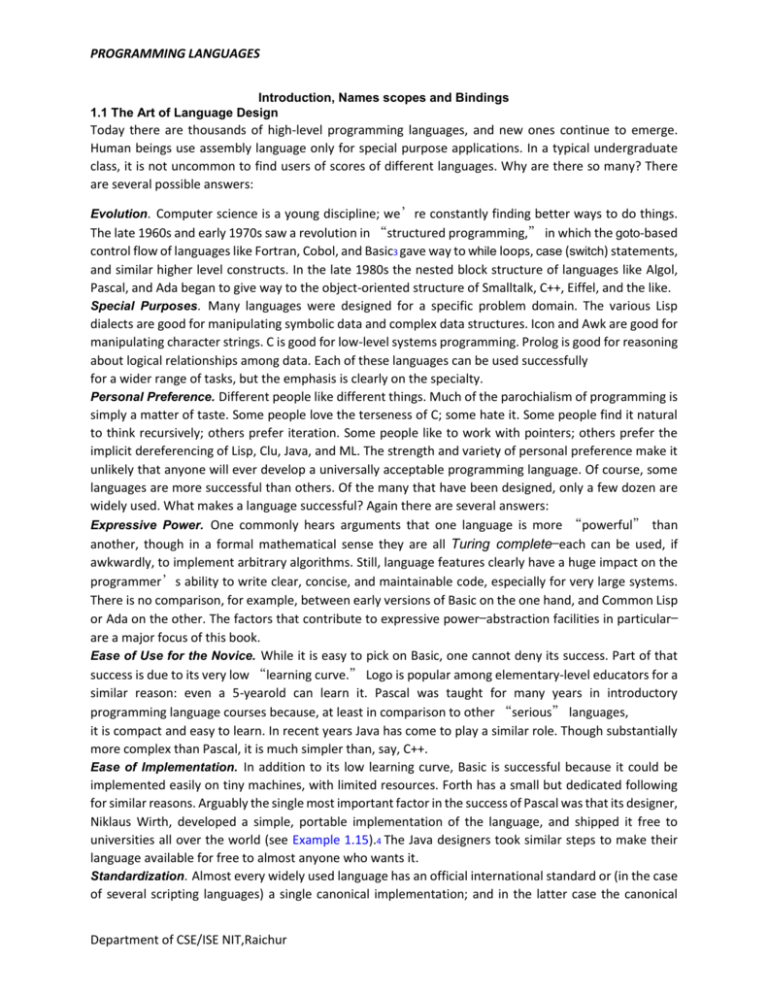
PROGRAMMING LANGUAGES Introduction, Names scopes and Bindings 1.1 The Art of Language Design Today there are thousands of high-level programming languages, and new ones continue to emerge. Human beings use assembly language only for special purpose applications. In a typical undergraduate class, it is not uncommon to find users of scores of different languages. Why are there so many? There are several possible answers: Evolution. Computer science is a young discipline; we’re constantly finding better ways to do things. The late 1960s and early 1970s saw a revolution in “structured programming,” in which the goto-based control flow of languages like Fortran, Cobol, and Basic3 gave way to while loops, case (switch) statements, and similar higher level constructs. In the late 1980s the nested block structure of languages like Algol, Pascal, and Ada began to give way to the object-oriented structure of Smalltalk, C++, Eiffel, and the like. Special Purposes. Many languages were designed for a specific problem domain. The various Lisp dialects are good for manipulating symbolic data and complex data structures. Icon and Awk are good for manipulating character strings. C is good for low-level systems programming. Prolog is good for reasoning about logical relationships among data. Each of these languages can be used successfully for a wider range of tasks, but the emphasis is clearly on the specialty. Personal Preference. Different people like different things. Much of the parochialism of programming is simply a matter of taste. Some people love the terseness of C; some hate it. Some people find it natural to think recursively; others prefer iteration. Some people like to work with pointers; others prefer the implicit dereferencing of Lisp, Clu, Java, and ML. The strength and variety of personal preference make it unlikely that anyone will ever develop a universally acceptable programming language. Of course, some languages are more successful than others. Of the many that have been designed, only a few dozen are widely used. What makes a language successful? Again there are several answers: Expressive Power. One commonly hears arguments that one language is more “powerful” than another, though in a formal mathematical sense they are all Turing complete—each can be used, if awkwardly, to implement arbitrary algorithms. Still, language features clearly have a huge impact on the programmer’s ability to write clear, concise, and maintainable code, especially for very large systems. There is no comparison, for example, between early versions of Basic on the one hand, and Common Lisp or Ada on the other. The factors that contribute to expressive power—abstraction facilities in particular— are a major focus of this book. Ease of Use for the Novice. While it is easy to pick on Basic, one cannot deny its success. Part of that success is due to its very low “learning curve.” Logo is popular among elementary-level educators for a similar reason: even a 5-yearold can learn it. Pascal was taught for many years in introductory programming language courses because, at least in comparison to other “serious” languages, it is compact and easy to learn. In recent years Java has come to play a similar role. Though substantially more complex than Pascal, it is much simpler than, say, C++. Ease of Implementation. In addition to its low learning curve, Basic is successful because it could be implemented easily on tiny machines, with limited resources. Forth has a small but dedicated following for similar reasons. Arguably the single most important factor in the success of Pascal was that its designer, Niklaus Wirth, developed a simple, portable implementation of the language, and shipped it free to universities all over the world (see Example 1.15).4 The Java designers took similar steps to make their language available for free to almost anyone who wants it. Standardization. Almost every widely used language has an official international standard or (in the case of several scripting languages) a single canonical implementation; and in the latter case the canonical Department of CSE/ISE NIT,Raichur PROGRAMMING LANGUAGES implementation is almost invariably written in a language that has a standard. Standardization—of both the language and a broad set of libraries—is the only truly effective way to ensure the portability of code across platforms. The relatively impoverished standard for Pascal, which is missing several features considered essential by many programmers (separate compilation, strings, static initialization, randomaccess I/O), is at least partially responsible for the language’s drop from favor in the 1980s. Many of these features were implemented in different ways by different vendors. Open Source. Most programming languages today have at least one open-source compiler or interpreter, but some languages—C in particular—are much more closely associated than others with freely distributed, peer-reviewed, community-supported computing. C was originally developed in the early 1970s by Dennis Ritchie and Ken Thompson at Bell Labs,5 in conjunction with the design of the original Unix operating system. Over the years Unix evolved into the world’s most portable operating system—the OS of choice for academic computer science—and C was closely associated with it. With the standardization of C, the language has become available on an enormous variety of additional platforms. Linux, the leading open-source operating system, is written in C. As of October 2008,C and its descendants account for 66% of the projects hosted at the sourceforge.net repository. Excellent Compilers. Fortran owes much of its success to extremely good compilers. In part this is a matter of historical accident. Fortran has been around longer than anything else, and companies have invested huge amounts of time and money in making compilers that generate very fast code. It is also a matter of language design, however: Fortran dialects prior to Fortran 90 lack recursion and pointers, features that greatly complicate the task of generating fast code (at least for programs that can be written in a reasonable fashion without them!). In a similar vein, some languages (e.g., Common Lisp) are successful in part because they have compilers and supporting tools that do an unusually good job of helping the programmer manage very large projects. Economics, Patronage, and Inertia. Finally, there are factors other than technical merit that greatly influence success. The backing of a powerful sponsor is one. PL/I, at least to first approximation, owes its life to IBM. Cobol and, more recently, Ada owe their life to the U.S. Department of Defense: Ada contains a wealth of excellent features and ideas, but the sheer complexity of implementation would likely have killed it if not for the DoD backing. Similarly, C#, despite its technical merits,would probably not have received the attention it has without the backing of Microsoft. At the other end of the life cycle, some languages remain widely used long after “better” alternatives are available because of a huge base of installed software and programmer expertise, which would cost too much to replace. 1.2 The Programming Language Spectrum Themany existing languages can be classified into families based on theirmodel of computation. Figure 1.1 shows a common set of families. The top-level division distinguishes between the declarative languages, in which the focus is on what the computer is to do, and the imperative languages, in which the focus is on how the computer should do it. Declarative languages are in some sense “higher level” ; they are more in tune with the programmer’s point of view, and less with the implementor’s point of view. Imperative languages predominate, however, mainly for performance reasons. There is a tension in the design of declarative languages between the desire to get away from“irrelevant” implementation details, and the need to remain close enough to the details to at least control the outline of an algorithm. The design of efficient algorithms, after all, is what much of computer science is about. It is not yet clear to what extent, and in what problem domains, we can expect compilers to Department of CSE/ISE NIT,Raichur PROGRAMMING LANGUAGES discover good algorithms for problems stated at a very high level of abstraction. In any domain in which the compiler cannot find a good algorithm, the programmer needs to be able to specify one explicitly. Within the declarative and imperative families, there are several important subclasses. Functional languages employ a computational model based on the recursive definition of functions. They take their inspiration from the lambda calculus, a formal computational model developed by Alonzo Church in the 1930s. In essence, a program is considered a function from inputs to outputs, defined in terms of simpler functions through a process of refinement. Languages in this category include Lisp, ML, and Haskell. Dataflow languages model computation as the flow of information (tokens) among primitive functional nodes. They provide an inherently parallel model: nodes are triggered by the arrival of input tokens,and can operate concurrently. Id and Val are examples of dataflow languages. Sisal, a descendant of Val, is more often described as a functional language. Logic- or constraint-based languages take their inspiration frompredicate logic. They model computation as an attempt to find values that satisfy certain specified relationships, using goal-directed search through a list of logical rules. Prolog is the best-known logic language. The termis also sometimes applied to the SQL database language, the XSLT scripting language, and programmable aspects of spreadsheets such as Excel and its predecessors. The von Neumann languages are the most familiar and successful. They include Fortran, Ada 83, C, and all of the others in which the basic means of computation is the modification of variables.7 Whereas functional languages are based on expressions that have values, von Neumann languages are based on statements (assignments in particular) that influence subsequent computation via the side effect of changing the value of memory. Scripting languages are a subset of the von Neumann languages. They are distinguished by their emphasis on “gluing together” components that were originally developed as independent programs. Several scripting languages were originally developed for specific purposes: csh and bash, for example, are the input languages of job control (shell) programs; Awk was intended for report generation; PHP and JavaScript are primarily intended for the generation of web pages with dynamic content (with execution on the server and the client, respectively). Other languages, including Perl, Python, Ruby, Department of CSE/ISE NIT,Raichur PROGRAMMING LANGUAGES and Tcl, are more deliberately general purpose. Most place an emphasis on rapid prototyping, with a bias toward ease of expression over speed of execution. Object-oriented languages trace their roots to Simula 67. Most are closely related to the von Neumann languages, but have a much more structured and distributed model of both memory and computation. Rather than picture computation as the operation of a monolithic processor on a monolithic memory, object-oriented languages picture it as interactions among semi-independent objects, each of which has both its own internal state and subroutines to manage that state. Smalltalk is the purest of the objectoriented languages; C++ and Java are the most widely used. It is also possible to devise object-oriented functional languages (the best known of these is the CLOS [Kee89] extension to Common Lisp), but they tend to have a strong imperative flavor. One might suspect that concurrent (parallel) languages also form a separate class (and indeed this book devotes a chapter to the subject), but the distinction between concurrent and sequential execution is mostly independent of the classifications above. Most concurrent programs are currently written using special library packages or compilers in conjunction with a sequential language such as Fortran or C. A few widely used languages, including Java, C#, and Ada, have explicitly concurrent features. Researchers are investigating concurrency in each of the language classes mentioned here. As a simple example of the contrast among language classes, consider the greatest common divisor (GCD) problem introduced at the beginning of this chapter. The choice among, say, von Neumann, functional, or logic programming for this problem influences not only the appearance of the code, but how the programmer The von Neumann algorithm version of the algorithm is very To compute the gcd of a and b, check to see if a and b are equal. If so, print one of them and stop. Otherwise, replace the larger one by their difference and repeat. C code for this algorithm appears at the top of Figure 1.2. _ Department of CSE/ISE NIT,Raichur PROGRAMMING LANGUAGES A Prolog version of this algorithm appears at the bottom of Figure 1.2. It may be easier to understand if one reads “if ” for :- and “and” for commas. It should be emphasized that the distinctions among language classes are not clear-cut. The division between the von Neumann and object-oriented languages, for example, is often very fuzzy, and most of the functional and logic languages include some imperative features. The descriptions above are meant to capture the general flavor of the classes, without providing formal definitions. Imperative languages—von Neumann and object-oriented—receive the bulk of the attention in this book.Many issues cut across family lines, however, and the interested reader will discovermuch that is applicable to alternative computational models in most chapters of the book. Chapters 10 through 13 contain additional material on functional, logic, concurrent, and scripting languages. Department of CSE/ISE NIT,Raichur
